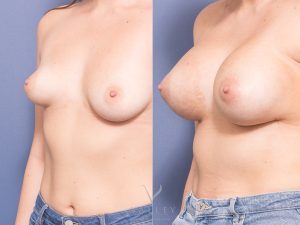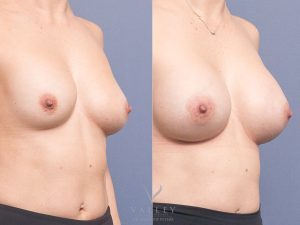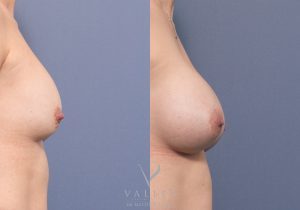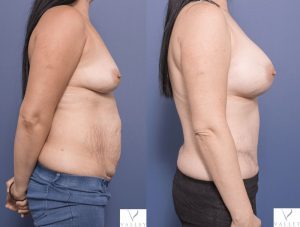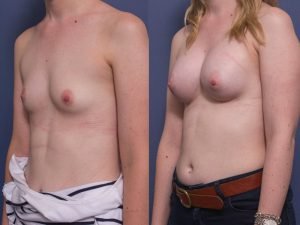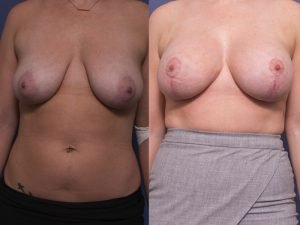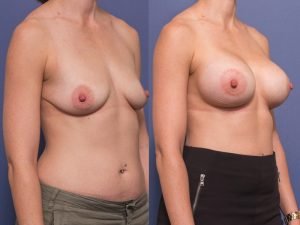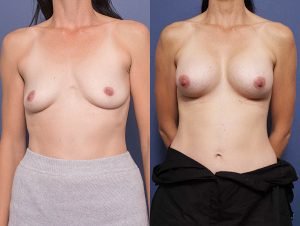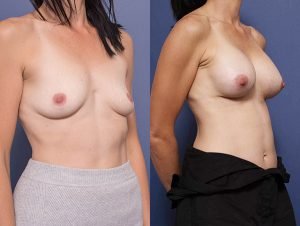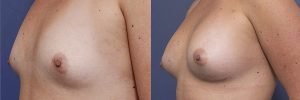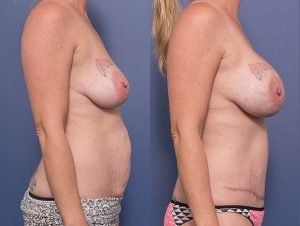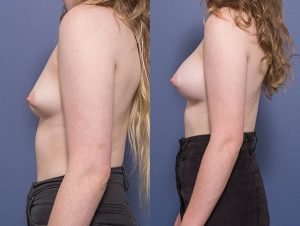Menu
Breast Augmentation
Breast augmentation is a highly individualised surgical procedure that may recover breast volume after weight reduction or pregnancy and breastfeeding. The procedure may also even up asymmetric breasts or be part of a reconstruction after mastectomy or injury.
Accessible Consultation Process
Surgery in Accredited Medical Facility
A Patient Care Focused Approach
Breast augmentation, also known as augmentation mammoplasty, can be a cosmetic procedure or a reconstructive procedure in the case of breast reconstruction surgery. The procedure involves implants being inserted beneath the breasts to enlarge them.
The implant type and size depends on factors such as how much bigger you want your breasts to be, your breast anatomy, skin thickness and elasticity, and body type.
The Breast Augmentation Procedure
A full consultation is required prior to any breast augmentation procedure. During this time, your surgeon will discuss your expectations, do an examination and determine the best course of treatment based on your individual needs. Finally, they will make recommendations to you regarding implant size, shape and profile.
During surgery, there are several different incisions that can be used to achieve the desired outcome. Your surgeon will discuss this with you during your consultation and may be able to use techniques such as placing the incisions in natural folds and creases, in order to conceal visible scarring.
This procedure is performed under general anaesthesia in an accredited hospital facility by a qualified Specialist Plastic Surgeon.
Following your surgery, follow up appointments are required at regular intervals to check on your progress and later on, the health of your implants. The final results of your surgery are evident after about three months.
Your Breast Implant Options
When deciding on the right breast implants, here are some of the choices you need to make:
- Implant type. This refers to the filling of the implant.
- Implant shape. Implants come in different shapes including round (fuller upper pole) or anatomical (more natural shape).
- Implant profile. The profile of your implant mainly depends on your goals and your body shape.
- Implant size. You can discuss sizes with their surgeon considering your desired result, anatomy and requirements.
Implantable Devices
If you are considering breast augmentation, you should review the Patient Information Leaflets that correspond to the type of breast implant you choose, as available via the links below. It is then recommended that you discuss any questions and concerns you have with your surgeon.
Breast Augmentation Before and After
Dr Matthew Peters
Dr Matthew Peters
Dr Matthew Peters
Dr Raymond Goh
Dr Raymond Goh
Dr Raymond Goh
Dr Matthew Peters
Dr Matthew Peters
Dr Matthew Peters
Dr Raymond Goh
Dr Raymond Goh
Dr Raymond Goh
Dr Matthew Peters
Dr Matthew Peters
Dr Matthew Peters
FAQ’s
How much does a breast augmentation cost?
Once you have met with your surgeon and a clinical plan has been established, our client support officers will organise a quote. Your quote will include a fee for your surgeon as well as an estimate of anaesthetist and hospital fees. There may also be costs associated with medication, pathology and post-surgery garments.
In some instances, for example if performed as part of a reconstructive procedure, a breast augmentation is considered medically necessary, and will attract a Medicare item number. If you are insured, your private health insurer may also cover some of the costs of your procedure, provided you meet the eligibility criteria.
What risks and side effects should I be aware of?
All surgical and invasive procedures carry risk, and these will be discussed during your consultation with your Specialist Plastic Surgeon. All of our procedures are carried out in accredited hospital facilities with assistance from FANZCA qualified anaesthetists.
Some of the specific risks associated with breast augmentation include implant rupture, capsular contracture and fluid build up. However, you will be provided with procedure specific information prior to your surgery with instructions to ensure that you are in prime condition prior to your procedure. You will also be provided with post-operative instructions outlining proper aftercare, including things to be aware of. Our specialised clinical team is available should you have any questions or concerns.
What steps should I take to prepare for breast augmentation surgery?
Prior to your procedure, it’s important to stay healthy. This means eating the right foods, getting enough sleep and exercise, and keeping your immune system strong. It’s also important to prepare for your recovery before your breast augmentation. You may wish to pre-prepare some healthy meals, purchase some comfortable loose clothing and ice packs, and fill any prescriptions you may need in the week following surgery.
You will need to arrange for someone to drive you home after your surgery and stay with you for a couple of days. This is particularly necessary if you have small children at home – you will need someone to assist you. You may wish to set up a recovery area where you can relax and sleep in an elevated position.
What can I expect after my breast augmentation surgery?
Discomfort, swelling, bruising and numbness are all normal after a breast augmentation. This will ease over the following weeks, and our clinic team will be able to offer you advice on effective pain management. A compression garment is worn after any breast surgery to reduce swelling and increase comfort during recovery. To drain excess fluid, you may have drains which will be managed with the help of nursing staff.
Patients need several days to rest and recover after an augmentation procedure. During the first few weeks after the procedure, heavy lifting, strenuous exercise and swimming is dis-couraged. Smoking should also be avoided to accelerate the healing process and prevent complications.
When do I need to replace my breast implants?
Provided there are no complications, modern implants can last for more than 10 years and they often come with a warranty for that period. It’s only necessary to replace your implants should you start to experience complications such as rupture and capsular contracture, or if the quality of your implant is compromised.
Can I breastfeed with implants?
There are no studies that indicate breastfeeding with implants is harmful to your child. The risks of injury during this procedure that could potentially impact breastfeeding are small however it is something that you need to be aware of when making your decision.
Can implants interfere with the detection of cancer?
There is a slight chance that breast implants can interfere with cancer detection if a mammography is used. If you’ve had breast cancer or have a history of cancer, it’s important to raise this with your surgeon prior to surgery.
Following your surgery, it’s important to continue regular self-examination of your breasts for any changes. If you have any concerns, please consult with your surgeon or general prac-titioner. Scheduling regular breast checks will ensure you can pick up on any abnormalities as soon as possible.
Do I need to combine breast augmentation with a lift?
If you’re considering augmentation to recover volume in your breasts after pregnancy or weight loss, a lift may also be required. Implants won’t reposition the breast skin or change the nipple position, only a breast lift can do that. By combining augmentation with a breast lift, the appearance of skin folds in the chest area may be addressed.
Adding a mastopexy to your surgery will alter the surgical approach, the cost and the time required to complete the procedure.
Ask us a question
Our wonderful team is standing by ready to answer any questions you have.
Breast Surgery Before & After
By Surgeons
Any surgical or invasive procedure carries risks. Before proceeding, you should seek a second opinion from an appropriately qualified health practitioner.




